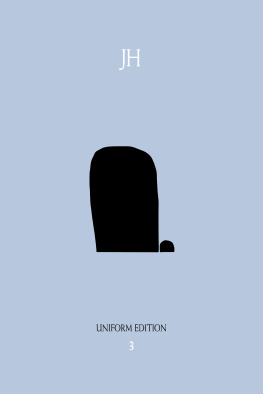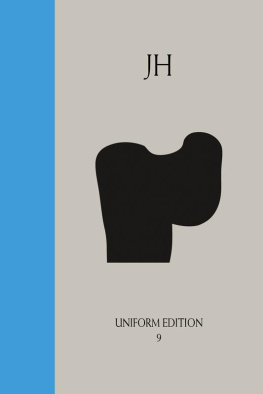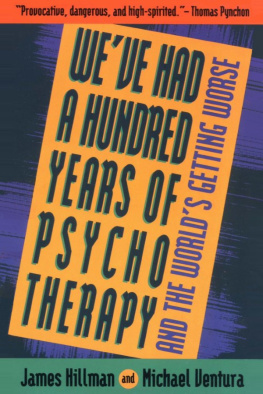Uniform Edition of the Writings of James Hillman
Series Editor: Klaus Ottmann
Volume 3: Senex & Puer
Copyright 2015 Margot McLean
All rights reserved
ISBN 978-0-88214-580-8 (e-book edition, v. 4.5)
Published by Spring Publications, Inc.
www.springpublications.com
Cover illustration:
James Lee Byars, Untitled, 1960. Black ink on Japanese paper. Estate of James Lee Byars; courtesy Michael Werner Gallery, New York, London, Berlin
The Uniform Edition of the Writings of James Hillman is published
in conjunction with Dallas Institute Publications,
Joanne H. Stroud, Director
The Dallas Institute of Humanities and Culture
an integral part of its publications program concerned with the imaginative, mythic, and symbolic sources of culture.
Additional support for this publication has been provided by
The Fertel Foundation
and by
Pacifica Graduate Institute and Joseph Campbell Archives and Library.
Introduction
James Hillman undoes. You enter his writing and a conversation or an argument will occur, either with him, with yourself, or with some well-worn belief system. Favorite theories will either be turned on their head or youll be guarding them all the closer. Passive readers beware: this work engages. Though his approach is not systematiche doesnt build models of the mindhis reflections are pointed and precise, sharply illuminating whatever terrain he traversespathology to politics, nature to nurture, antiquity to Armageddon. Yet his concern is always more vertical than horizontal. Hillman lifts rocks and reveals the strange creatures beneath. He locates fissures of narrow-mindedness and drops into their blind spaces. Unraveling conventional wisdom and codified understanding, he makes room for new ways to be psychological. The undoing always becomes an opening. The result is a different perspective, one that deepens before it explains. The consistent goal: To put psyche (soul) back into psychology.
Today psychology rarely inspires. Materialism and numbers have eclipsed interiority. Cognitive-behaviorism and neuroscience dominate the landscapeflatlands where subjects are quantified, therapies are determined economically, and pills are given before anyone asks, whats wrong? Functionality reigns. There is no room for the dream, less for meaning and little for the imagination. Most theorists have abandoned the depth perspectives of Freud and Jung, thinkers whose works constantly ignite discourse in the humanities and remin mainstays of popular soul-searching. Psychology has placed itself inside a Skinnera boxa place with an empty interior where psychologists map the brain and observe activity. It is this boxed-in psychology that is grist for Hillmans mill.
When efficiency and functionality become psychologys primary goal, the programmable machine becomes its primary metaphor. Medicine already convinces us that psychopathology is a chemical imbalance. These trends force complex, multi-faceted soul-realities outside the field. To find psyche one must get into Buddhism, read pop psychology books and take New-Age workshops. Whereas these alternate paths may sustain for a time, they are notoriously evasive of the souls disturbances and they often lack a nose for cultural shadows; they may have psyche, but little critical logos. Between scientism and self-help, psychology proper, the logos of psyche, finds itself homeless.
Hillmans work reverses this kind of alienation of the psyche. His writings recover an authenticity and vitality within the field. Staying close to emotion, fantasy and metaphor, to the more poetic and imaginative basis of mind, his ideas stir the heart while waking the intellect. Religion and myth are predominant themes, providing expressions that have always been the psyches mirror. Courting rather than denying mystery, Hillman follows psychological life through its innate forms. He lingers in dark places and rarely settles on easy, unambiguous understandings. The driving concern is for apt perspective insight that satisfies through its very way of seeing, so that the process of being psychological, referred to by him as soul-making,
Senex and Puer
This volume, for the first time, collects James Hillmans running encounters with a primary psychological pattern, an archetype that arises alongside the very attempt to fashion psychological perspective. Senex and puer are Latin terms for old man and youth, and personify the poles of tradition, stasis, structure, and authority on one side, and immediacy, wandering, invention and idealism on the other. The senex consolidates, grounds, and disciplines; the puer flashes with insight and thrives on fantasy and creativity. These diverging, conflicting tendencies are ultimately interdependent, forming two faces of the one configuration, each face never far from the other. Old and new maybe the most direct terms for the pair. They represent two very different ways of entering the world, but are oddly dependent on one another.
Senex and puer are not hidden. They do battle on the world-political and social stage, underpinning profound rifts between rigid conservatism and freewheeling expression evident everywhere we turn. Late-night television and talk shows face them off as a formula for capturing an audience, reconfirming the polarity every day. The embers from these collisions fly into living rooms and fire up entire world views. The senex-puer split can start wars and determine the course of history. It may be seen in the political divisions of the Vietnam era (Hillmans writings on this topic began in 1967). It is in the suicide bombers flight to immortality in the face of monolithic powers. It is in the confrontations between disenfranchised youth and the World Trade Organization. It lives in the psychological and cultural divide between reign of Reagan and the collapse of Clinton, in the tenacity of one and the vulnerability of the other. The puer surfaced in the idealism of flower power. Today he infuses the mercurial minds of Silicon Valley, who show senex faces when their companies move to Wall Street. The puer is in the twinkle-in-the-eye creatives who can never realize their vision; the senex enters at midlife, when the soul turns dry, vision has dimmed and unlived life begins to plague us. This pair is all around, roaming unrecognized and in need of our attention.
As fundamental patterns of psychological life, Hillman sees the senex and puer at work in interior processes. He suggests that this specific archetype will be involved with the process character of any (psychological) complex. More precisely,
the puer personifies that moist spark within any complex or attitude that is the original dynamic seed of spirit. It is the call of a thing to the perfection of itself, the call of a person to the Self, to be true to itself, to maintain the connection with its own divinely created eidos.
Elsewhere, he indicates the accompanying role of the senex:
Therapy becomes a working on Saturn, a depressive grinding of the most recalcitrant encrustations of the complex, its oldest habits, which are neither childhood remnants nor parental introjections, but are senex phenomena, that is, the structure and principles by which the complex endures.
Puer and senex reside within psychological complexesthose black holes of inner life that bind history and emotion, wound and aspiration, past, present, and future. Jung claimed the complex to be the via regia of the unconscious. According to Hillman, work with any complex becomes an encounter with the senex-puer duality. Puer and senex appear along with our attitudes and feelings toward each complex. Psychotherapy is therefore called to recognize both the moist spark and the depressive grinding and find adequate vessels to hold these colliding energies. For instance, an inferiority complex may be draining, debilitating, pulling us back into the past, yet work on the complex may also release sparks of new potential and become fertile ground for future pursuits and callings; the old inferiority fuels the new determination. New meets old when the imagination searches for openings in constrictions and habits. This approach reunites the pair and maintains the too often broken bonds of symptom and soul.
Next page










